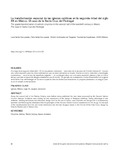La transformación espacial de las iglesias católicas en la segunda mitad del siglo XX en México: el caso de la Santa Cruz del Pedregal

View/
Use this link to cite
http://hdl.handle.net/2183/23074Collections
Metadata
Show full item recordTitle
La transformación espacial de las iglesias católicas en la segunda mitad del siglo XX en México: el caso de la Santa Cruz del PedregalAlternative Title(s)
The spatial transformation of catholic churches in the second half of the twentieth century in Mexico: The case of Santa Cruz del PedregalDate
2005Citation
Santa-Ana Lozada, L., & Santa-Ana Lozada, P. (2017). La transformación espacial de las iglesias católicas en la segunda mitad del siglo XX en México. Actas De Arquitectura Religiosa Contemporánea, 4, 88-95. https://doi.org/10.17979/aarc.2015.4.0.5123
Abstract
[Resumen] A lo largo de la segunda mitad del s. XX, los arquitectos mexicanos —aún antes de la clausura del Concilio Vaticano II— buscan una nueva expresión para las obras eclesiásticas que se están realizando en el país. Gracias a nuevos materiales y tecnologías constructivas —como el uso de superficies regladas—, se construyen obras con una nueva expresión plástica y que, al mismo tiempo, permiten el desarrollo litúrgico establecido por el concilio. Un ejemplo de la adaptación a estos lineamientos es la iglesia de la Santa Cruz del Pedregal, en donde el arquitecto Antonio Attolini Lack transforma un proyecto planteado a la antigua usanza en un templo contemporáneo. [Abstract] Along the second half of the Twenty Century, even before being published the new ideas proposed by the Second Vatican
Council, Mexican Architects were looking for new expressions in the design of Religious buildings. Taking advantage of new materials, building techniques and structural design such as the use of hypars, new churches are design with a contemporary aesthetic and following the distribution that the principles of the Second Vatican Council established for the liturgy. An example of the transformation from the old model distribution into the new liturgical needs is the Church of the Holy Cross design by Antonio Attolini Lack in Mexico City.
Keywords
Iglesias
México
Siglo XX
Espacio
Evolución
Churches
Mexico
Twenty Century
Space
Evolution
México
Siglo XX
Espacio
Evolución
Churches
Mexico
Twenty Century
Space
Evolution
Editor version
Rights
Atribución-NoComercial 4.0 España
ISSN
2340-5503






